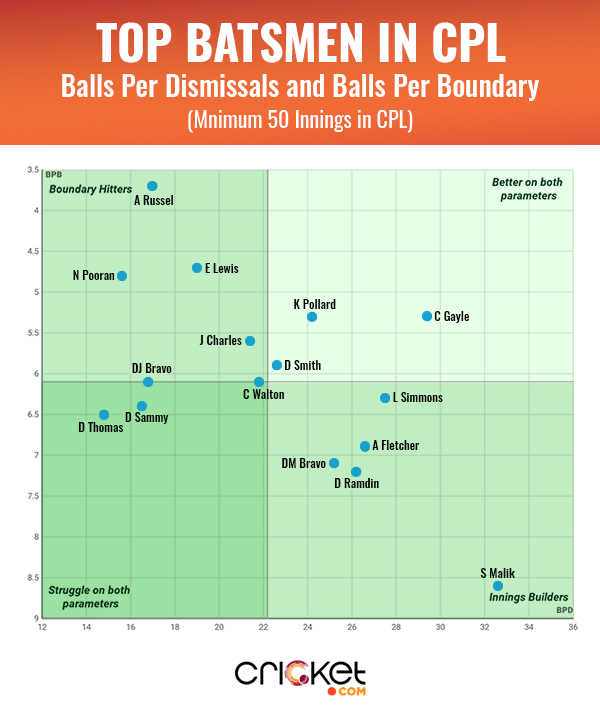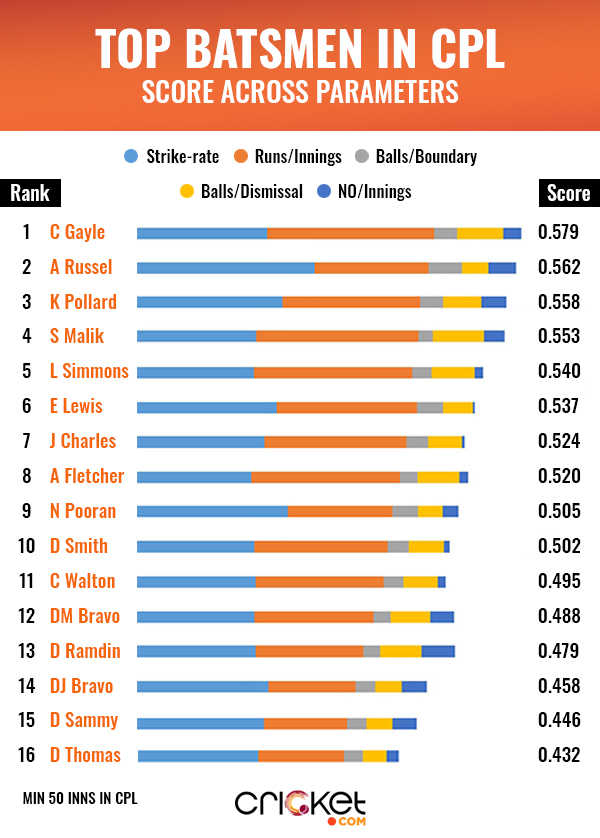 OPINION
OPINIONIn the words of Ian Bishop, life in the outdoors is a part of the West Indies culture. This makes their cricketers “hardworking, physically demanding people who love to smash the ball to the boundary”. To the dismay of coaches sometimes, hitting the ball out of the nets and out of the grounds was a part of regular sessions even during his playing days. It is no wonder then that the batsmen from the Caribbean are natural T20 hitters.
By the time of the first edition of the Caribbean Premier League in 2013, West Indian batsmen had become the destroyer-in-chief for their franchises across the globe. By then, Chris Gayle had scored 175 runs in a T20 innings, a record still unbroken. Since the launch of the CPL, the trend of West Indies batsmen being a key member for their franchises has seen an upward trend.
Possessing the gift of power and fearlessness, batsmen from no other nation like to hit sixes as much as those from the West Indies do. While hitting is the most important ingredient for a T20 batsman, there is a lot more skill required for a batsman to be a match-winner.
How does then one arrive at the best batsmen in a league for a format that might seem skewed towards the top-order? To achieve this, we must account other aspects of batting besides runs per innings and strike-rate.
To account for other batting we look into parameters such as balls per boundary, balls per dismissal and not-outs. Balls per boundary help us identify the frequency of a batsman to hit fours and sixes – a necessary ingredient for a T20 batsman. Balls per dismissal tell us about the tendency of a batsman to stick around to build an innings. Not-outs bring the lower-order batsmen into play with their ability to finish the game for their team.
Unlike the Indian Premier League, the churn in CPL is very high. The proportion of players regularly involved in every season, especially those from outside the Caribbean, is very low. To reward consistency, we have used the criteria of a minimum of 50 CPL innings for our analysis here. Before we dive into the calculations, let us look at how the 16 CPL batsmen with a minimum of 50 innings fare across the above parameters –


There are a few expected contenders like Chris Gayle and Kieron Pollard who dominate all aspects of T20 batting. But, there is a heavy muddle of relatively similar batsmen that we need to analyse further.
To account for these, we build a model that includes all the five parameters described earlier to generate a score for each batsman in the IPL. The approach that we opt for in this exercise is the Multi-Criteria Decision Making (MCDM). It is an approach to help decision-makers to rank objects (players/products/candidates) based on several criteria. This is widely used in various domains such as business, medicine, industries, etc.
These criteria may represent different aspects. For example: while purchasing a car, we look at safety, comfort, price, colour, fuel efficiency. Our main objective is to get the best car considering all the above factors. For batting in the CPL, the parameters for the analysis are: (a) runs per innings, (b) strike-rate, (c) balls per boundary, (d) balls per dismissal and (e) not-outs.
AHP (Analytic Hierarchy Process) is one of the MCDM methods. Here, we use pair-wise comparisons to estimate the weights of each parameter. E.g. first, we rank strike-rate in comparison to the other four parameters. Then, we do the same for runs per innings and we continue to do it for other three parameters as well to arrive at the final weights for each one of them.
These comparisons can be subjective. But, since all the five parameters are objective in nature we opted for a mathematic approach. We looked into the impact of each of these five parameters towards victory in an IPL game. Our observations suggest the following
1. The number of runs scored by a batsman over and above run-a-ball is the most impactful differentiator between winnings and losing team. (i.e. runs per innings)
2. A higher runs per innings ratio then follows the order of importance towards victory (i.e. strike rate)
3. The third important parameter is having a low balls per boundary record.
4. The last two parameters – balls per dismissal and not-outs – have an equal impact. For not-outs, we use not-out/innings to bring all numbers to a per match scenario.
To obtain the final score, we check how far each batsman is on a particular parameter from the worst-performing batsman across that parameter. Then we use these numbers calculated for each parameter along with the weights as per the ranks of these parameters to arrive at a final score.

It is no surprise that Chris Gayle is at the top of the charts. He is Bradmanesque when it comes to batting in the T20 format. He tops the CPL charts in most runs scored: 2354, most fifty-plus scores: 17, most sixes: 162 and joint-most centuries scored: 4, along with Dwayne Smith. He has hit 2.2 sixes on an average per inns, the best in CPL. As he opted out of this year’s edition citing personal reasons, he will not get a chance to add to his impressive CPL resume.
At number two is the one who carries the baton of Gayle’s legacy forward. Gaining the reputation of the most fearsome hitter ever in T20 cricket with each passing year is Andre Russell. His strike-rate of 181.2 is above any CPL batsmen with 100 or more runs in the league. His record of 3.7 balls per boundary is better than any batsmen with a minimum of 20 boundaries in CPL. He also holds the record of fastest century in CPL that came in 40 balls. Add to it an average of 30.8 and you are looking at one of the greatest batsmen in CPL.
Kieron Pollard has scored the most runs among non-openers in CPL: 1759. A master of death overs, he is the only player in CPL to score over 1000 runs while batting in the overs 16-20. Batting at the death, his strike-rate of 199.1 is the second-best and the balls per boundary record of 3.6 is the third-best among players with 200+ runs in this phase.
Shoaib Malik has scored the most runs by an overseas player in CPL: 1707. He the most fifties for a non-opener in CPL: 12. His batting average of 39.7 is the second-highest among batsmen with a minimum of 300 runs in CPL. As he is part of the Pakistan T20I team to play against England later this month, he too will not be a part of this year’s CPL.
Rounding off the top-5 CPL batsmen is Lendl Simmons. He holds the record of the most number of the fifties in CPL: 16. With 2080 runs, he is also the second leading run-scorer in CPL. Along with Gayle and Chadwick Walton, he is one of the only three players to score over 1000 runs in chases in CPL averaging an impressive 34.4.
A noteworthy omission from the top-5 is Nicholas Pooran. His low runs per innings record of 19.9 push him to the number-10 spot.
Now, there are a few batsmen who have do not have 50 CPL innings yet and hence are not part of the top batsmen in the above analysis. But, these are the future stars that are knocking on the door of being among the greatest CPL batsmen.

CPL is set to become the first T20 tournament after the hiatus due to the pandemic. The flair of so many great hitters is certain to bring momentary joy to cricket lovers.